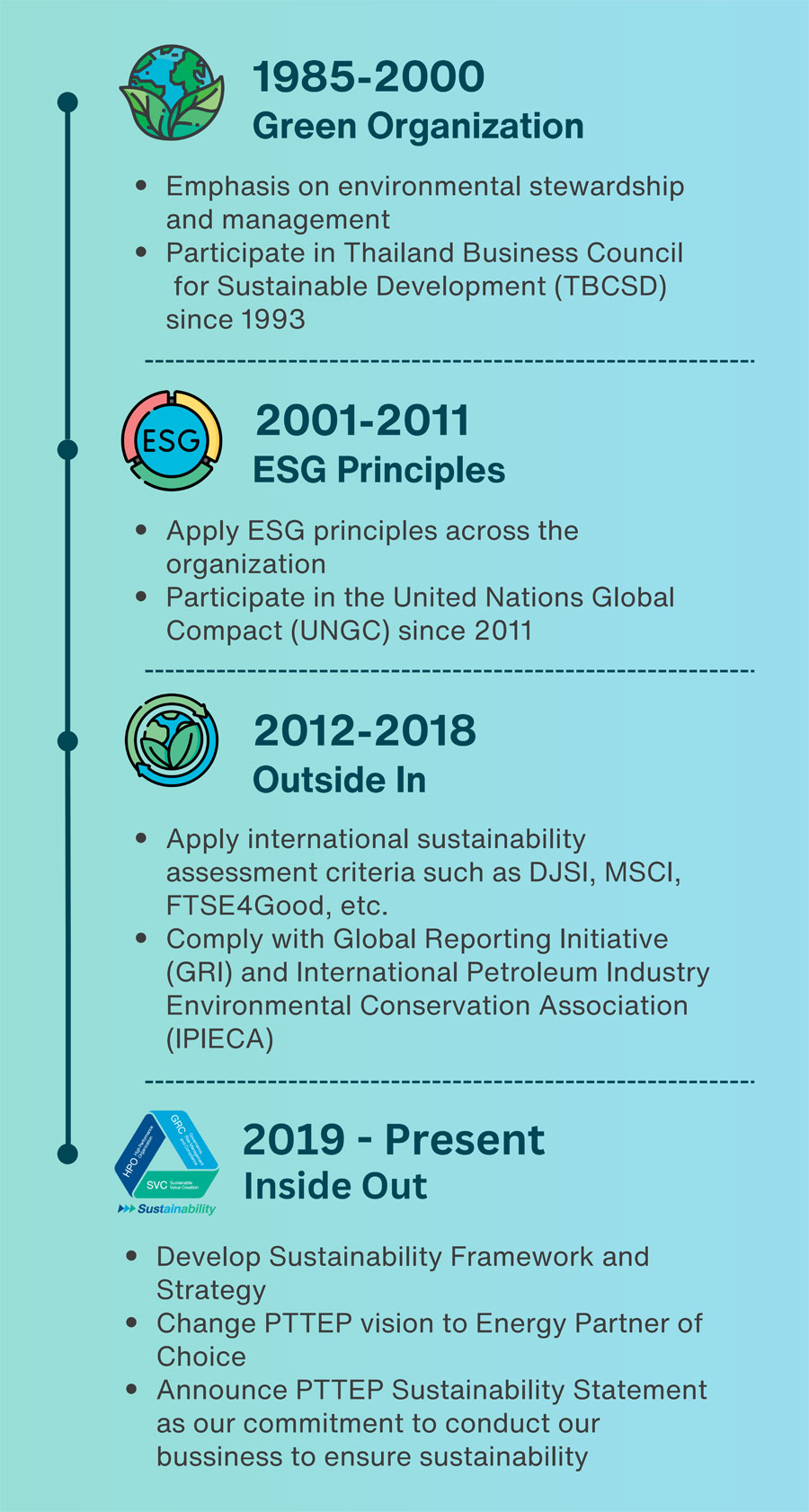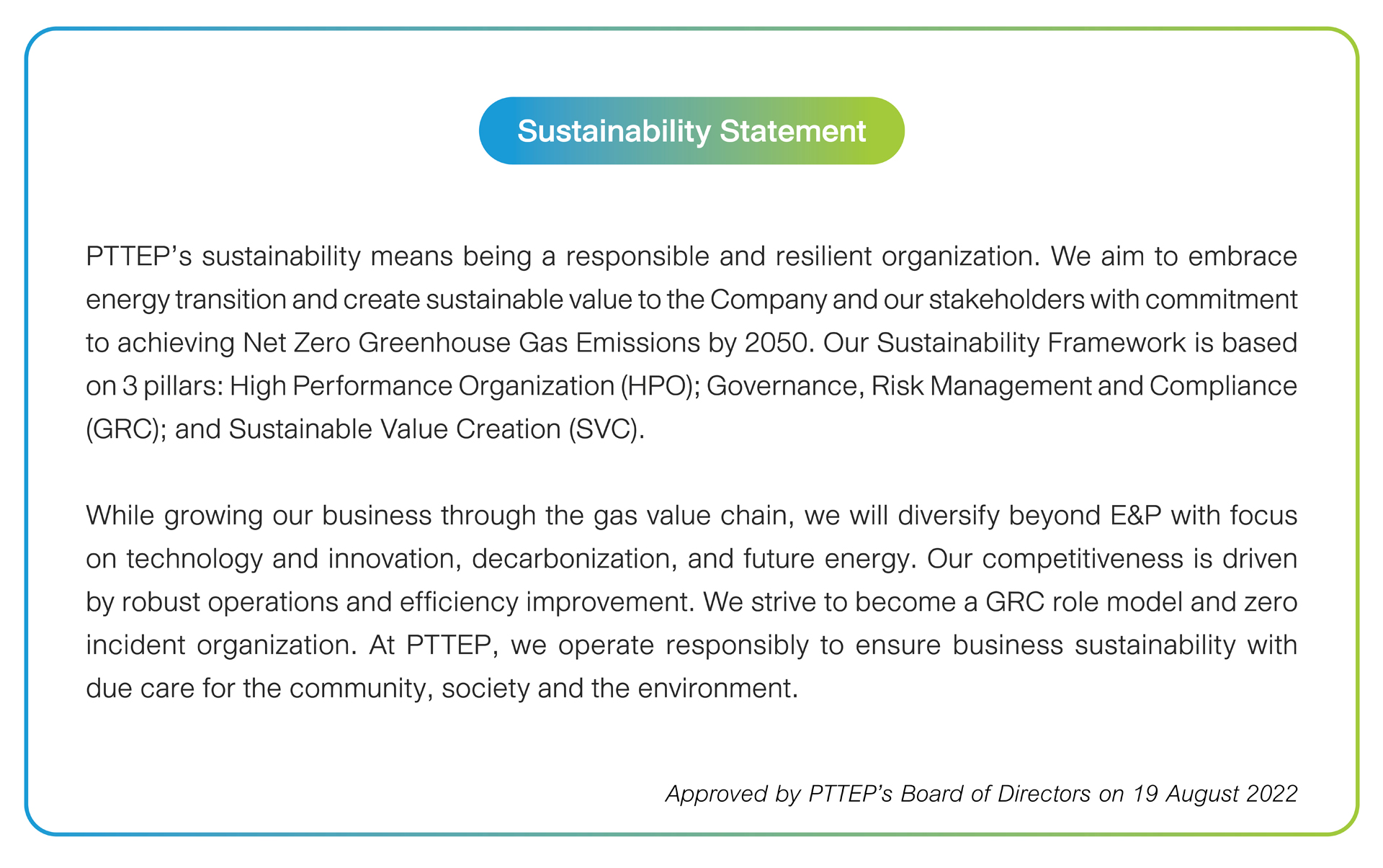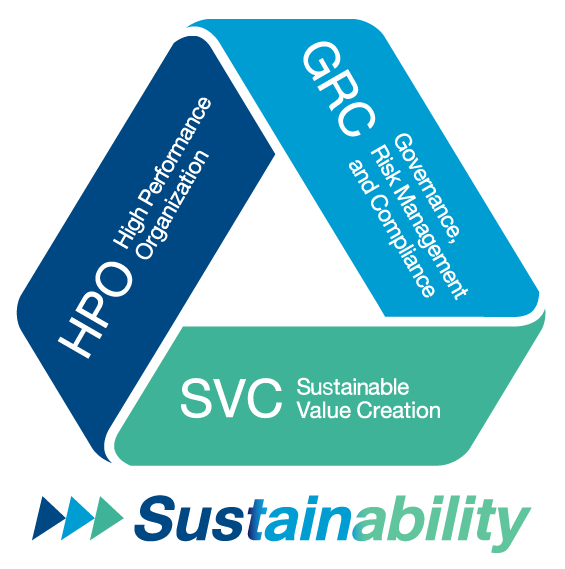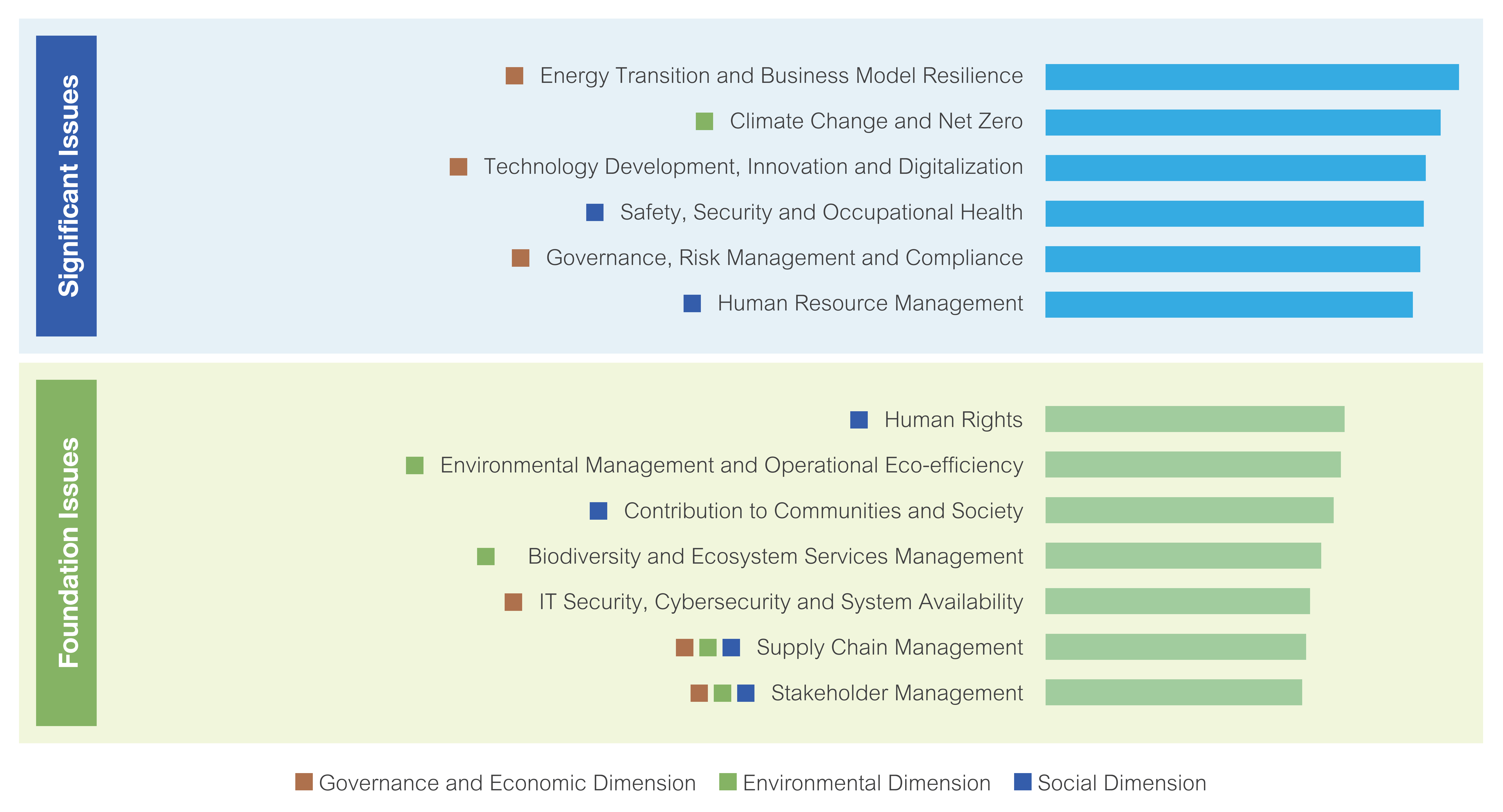
Sustainability Framework and Long-term Target
Sustainability Journey
PTTEP set sight to become a sustainable organization since its inception in 1985. The journey started with a goal to be a "green organization" to which environment stewardship and management was a priority. The sustainability concept that involves Environmental, Social and Governance elements was subsequently applied and in 2011, PTTEP participated in the United Nations Global Compact (UNGC), demonstrating our commitment to uphold the UNGC 10 principles that highlight 4 main aspects - human rights, labor, environment and anti-corruption. PTTEP has submitted the Communication on Progress to the UNGC annually since 2012 up to the present.

Moreover, PTTEP has adopted several international sustainability assessment criteria, like Dow Jones Sustainability Indices (DJSI), MSCI, FTSE4Good, etc. as part of its sustainability management. In addition, the sustainability reporting complies with Global Reporting Initiative (GRI) and International Petroleum Industry Environment Conservation Association (IPIECA) which are guidelines on international sustainability.
In 2019, PTTEP formulated Sustainability Framework and set clear long-term targets (2030) in alignment with the Company’s key strategies. Under the inside-out approach, PTTEP strived for impressive performance on strong business foundation, to deliver sustainable values to society (From We to World).
In 2020, the Board of Directors made an important step in pushing the organization's sustainability for concrete implementation. The Sustainability Statement was formulated to ensure common understanding among employees and other stakeholders. Moreover, the Corporate Governance and Sustainability Committee is in place to establish policies, targets, and workplans for good corporate governance and business ethics; and sustainability. The committee is also tasked to promote PTTEP’s overall sustainability implementation, including monitoring, evaluating, and disclosing sustainability performance to stakeholders, through committee meetings at least 4 times a year.

Sustainability Framework and and Long-term Target
Sustainability Framework
PTTEP has a firm belief that the "Right Balance" of economic, social, and environmental aspects lead to a strong foundation for business sustainability. We have then developed "Sustainability Framework" to steer our business operations. This framework plays a pivotal role in ensuring business continuity to promote energy security while safeguarding both society and the environment. At PTTEP, we recognize the importance of building sustainability from within by fostering strong business performance on a robust business foundation. The goal is to create long-term value for all stakeholders while contributing to the sustainability of the society as a whole (From We to World), aligned with our vision to become the “Energy Partner of Choice”.
The Sustainability Framework emphasizes High Performance Organization (HPO), Governance, Risk Management and Compliance (GRC), and Sustainable Value Creation (SVC). The framework supports 17 United Nations Sustainable Development Goals (UN SDGs), focusing on 3, 7, 8, 9, 12, 13, 14,15 and 16 which are directly related to the Company's strategies, business operations, and long-term targets.

- High Performance Organization (HPO)
Emphasizing continuous performance improvement to become more effective, efficient, and productive in response to the energy transition with a focus on technology and innovation, decarbonization and future energy. - Governance, Risk Management and Compliance (GRC)
Emphasizing transparent and efficient operations for the organization's stability and sustainability through governance, appropriate risk management, and internal control as well as strict compliance with relevant laws and regulations. - Sustainable Value Creation (SVC)
Emphasizing long-term value creation for all stakeholder groups through organizational sustainability, responsible operations, natural resource conservation, environmental rehabilitation as well as community and social development.
Material Topic
Materiality Assessment Process
In 2023, PTTEP assessed and reviewed material issues on sustainability including ESG issues based on Double Materiality approach, considering the significance of issues in terms of impact on PTTEP and impact on environment, society (including impacts on human rights) as well as governance and economy, from the perspective of 8 key stakeholder groups: (1) Government Agencies and Regulators (2) Vendors and Contractors/Suppliers (3) Customers (4) Employees and Directors (5) Shareholders and Financial Institutions (6) Business Partners, Consortium and Joint Ventures (7) Communities and Society (8) Press and Media. The material issues were prioritized according to the Global Reporting Initiative Standards: GRI Standards (2021) and AA1000 AccountAbility Principles: AA1000APS (2018). The material issues reflected national and international sustainability trends corresponding with the United Nations Sustainable Development Goals and Sustainability Accounting Standards Board's SASB Materiality MapTM for Oil & Gas – Exploration & Production Industry. The materiality assessment results served as part of the crucial inputs for shaping and improving corporate strategies. These results were also integrated into the Enterprise Risk Management process, empowering PTTEP to proactively address any risks related to the Company's sustainability material issues. The assessment process can be summarized as follows:
- Understanding the Organization's Context
•Review entire business activities, business relationships, sustainability context, and all stakeholders throughout the value chain.•Review global trends, conduct peer reviews across the industry and engage with relevant stakeholders to predetermine material issues.
- Identifying Actual and Potential Impacts
•Identify actual and potential impacts of material issues encompassing environment, society (including impacts on human rights) and governance and economy, for both positive and negative impacts as well as opportunities for positive contributions, in the short term and long term, covering all PTTEP's business activities throughout the value chain via conducting an interview session with relevant stakeholders and gathering other perceptions via an online survey.
- Assessing the Significance of the Impacts
Based on the principles of double materiality, the assessment method is shown as follows:•Engage with external stakeholders to obtain their perceptions on the Company's impacts on environment, society (including impacts on human rights) as well as governance and economy.•Engage with internal stakeholders (employee group) to obtain their perceptions on sustainability-related impacts on the Company.•Assess and determine the significance of identified impacts from stakeholder engagement by considering 2 dimensions: 1) severity (scale, scope, irremediability) and 2) likelihood of the impacts. - Prioritizing the Most Significant Impacts
•Define selection criteria for key material issues.•Validate key material issues against external professional views covering ESG dimensions. Then, combine the impact score from expert testing with the score obtained from the stakeholders.•Group interconnected material issues into material topics and propose for approval by the Management Committee and for acknowledgement by the Corporate Governance and Sustainability Committee.•Incorporate material topics as part of the key inputs for shaping and enhancing the Company’s sustainability strategy.•Gather data on sustainability performance across all material topics for public disclosure through diverse channels to efficiently respond to each stakeholder group. Then, collect feedback and recommendations from relevant stakeholders to improve the efficiency of business operations.
2023 Material Topic

Corporate Strategy and Sustainability Long-term Target
PTTEP is committed to delivering sustainable value from within to support the wider society (From We to World) and supporting the UN SDGs while considering the benefits of all stakeholders involved. Our corporate strategy is formulated with a focus on ensuring energy security and business resilience to address the ongoing global crisis and navigate the energy transition, together with environmental conservation. Therefore, PTTEP has established 3 business strategic pillars and sustainability long-term targets encompassing ESG dimensions as follows:

Sustainability Collaboration and Networking
Collaboration and networking play a crucial role for both PTTEP's current business operations and future growth. We, therefore, emphasize the importance of establishing business, social and environmental collaborations and networks with relevant parties to support the Sustainable Development Goals of Thailand and the United Nations; as well as PTTEP's vision of "Energy Partner of Choice".
Currently, PTTEP actively participates in various sustainability-focused networks, including the United Nations Global Compact (UNGC), Global Compact Network Thailand (GCNT), Thailand Business Council for Sustainable Development (TBCSD), Thailand Responsible Business Network (TRBN), and the ESG Network of the Thai Listed Companies Association.
Furthermore, PTTEP acknowledges the significance of driving public policies with government agencies by leveraging its knowledge and initiatives to effectively address national issues such as climate change and biodiversity. PTTEP actively participates in various sustainability committees/ networks, including serving on the Climate Action through CCUS Application Subcommittee under the National Climate Change Policy Committee and participating in the Thailand Carbon Neutral Network. Moreover, PTTEP has established a Memorandum of Understanding (MoU) with the Office of Natural Resources and Environmental Policy and Planning to launch joint actions on climate change and biodiversity conservation, and an MoU with the Royal Forest Department; the National Park, Wildlife and Plant Conservation Department; Marine and Coastal Resources Department; as well as PTT Group for a two-million-rai reforestation project. PTTEP also has collaboration agreement with leading university and institutes to foster research and development networks through collectively leveraging their organizational knowledge. Examples include an MoU with Kasetsart University to promote ocean sustainability, an MoU with the Hydro-Informatics Institute to develop an ocean data platform, and an MoU with Mae Fah Luang Foundation under Royal Patronage to conserve and restore natural resources through community engagement and application of technology for sustainable development.
In addition, PTTEP actively engages in relevant Thailand public hearing process such as draft Thailand Climate Change Act, draft Biodiversity Conservation (Areas & Species) Act, and draft Thailand Taxonomy of the Bank of Thailand (BOT), in which the current scope and boundary does not include oil and gas exploration and production. The progress of the Thailand Taxonomy is being closely monitored to ensure appropriate and timely response of the Company.
